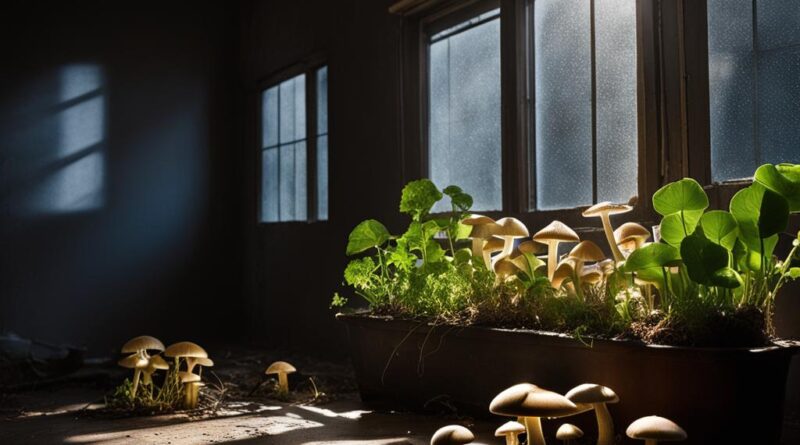Mushrooms Growing in House: Causes & Solutions
If you find mushrooms growing inside your home, it is likely a sign of moisture and mold issues. When you see mushrooms, it indicates the presence of mold, which is caused by water intrusion or leaks in your home. Simply removing the mushrooms will not solve the underlying issue, as the mold will continue to grow. It is essential to identify the source of the water intrusion and address it to prevent further mushroom growth.
Key Takeaways:
- Mushrooms growing in your house are a sign of moisture and mold issues.
- Removing the mushrooms alone will not solve the problem, as the mold will continue to grow.
- The source of water intrusion or leaks must be identified and fixed to prevent further mushroom growth.
- Professional help may be needed to address the underlying moisture issue in your home.
- Regular inspections and moisture control are crucial in preventing mushroom growth and maintaining a healthy home environment.
What Causes Mushrooms to Grow Indoors?
Mushrooms growing indoors are a result of excessive moisture and humidity. They thrive in damp environments and are often a sign of water damage or leaks. The presence of mushrooms indicates the presence of mold, which can be harmful to your health. It is important to address the underlying moisture issue to prevent further mushroom growth.
Mushrooms have the remarkable ability to grow in a wide range of environments, including indoors. While outdoor mushroom cultivation is well-known, indoor mushroom cultivation has gained popularity among enthusiasts and home gardeners. Growing mushrooms indoors provides a convenient and controlled environment for their cultivation, allowing for year-round production and a steady supply of fresh mushrooms.
To understand what causes mushrooms to grow indoors, it is crucial to consider the environmental factors that contribute to their cultivation. Mushrooms are a type of fungi that require specific conditions to thrive. These conditions include:
- Moisture: Mushrooms require high levels of humidity to grow. Excessive moisture in the air or on surfaces can provide the ideal breeding ground for mushroom spores to take root and develop into full-grown mushrooms.
- Warmth: Mushrooms prefer warm temperatures for optimal growth. While different mushroom species have varying temperature preferences, a temperature range of 65-75°F (18-24°C) is generally suitable for most indoor mushroom cultivation.
- Darkness: Unlike plants, mushrooms do not require sunlight for photosynthesis. In fact, they thrive in dark or dimly lit environments. This makes indoor spaces with little or no natural light potential locations for mushroom growth.
- Ventilation: Although mushrooms do not require direct airflow, proper ventilation is essential to prevent the build-up of stagnant air and excessive moisture. Good air circulation helps regulate humidity levels and prevents the growth of mold and bacteria that can compete with mushrooms.
Mold and Mushroom Growth
When mushrooms grow indoors, it is often a sign that there is an underlying moisture issue or water damage. This excess moisture creates an ideal environment for mold growth, which accompanies the growth of mushrooms. Mold spores are naturally present in the air, and they can settle on damp surfaces, such as walls, ceilings, or organic materials, and start to develop into visible mold colonies.
“Mushrooms and mold are closely related. The presence of mushrooms indicates that there is a moisture problem, and where there is moisture, you will likely find mold.”
If left unaddressed, mold growth can spread and become a health hazard. The spores released by molds can cause allergic reactions, respiratory problems, and other health issues in susceptible individuals. Therefore, it is essential to tackle both the mushroom growth and the underlying moisture issue to protect your health and maintain a safe indoor environment.
By identifying and correcting the source of excess moisture, you can prevent further mushroom growth and minimize the risk of mold-related health problems. Regular inspections for leaks, addressing water damage promptly, maintaining appropriate humidity levels, and ensuring proper ventilation are key steps in preventing mushrooms from growing indoors.
Avoiding Mushroom Growth
“Prevention is better than cure.” This saying holds true in the case of mushrooms growing indoors as well. Taking proactive steps to prevent mushroom growth is essential to maintaining a healthy indoor environment while avoiding unnecessary remediation efforts.
Here are some preventive measures that can help you avoid unwanted mushroom growth:
- Control indoor humidity: Keep humidity levels between 40-60% to discourage mold and fungi from growing. Use dehumidifiers or air conditioners in areas prone to excessive moisture.
- Fix leaks promptly: Inspect your home regularly for any water leaks or signs of water damage. Addressing leaks promptly prevents the build-up of moisture and the growth of mold and mushrooms.
- Promote air circulation: Ensure that your indoor spaces are adequately ventilated to prevent stagnant air and excess moisture. Use fans, open windows, and maintain proper airflow to discourage mushroom growth.
- Remove damp materials: Promptly remove any damp or wet materials from your home, such as wet carpeting, rugs, or cushions. These materials can become breeding grounds for both mold and mushrooms.
By following these preventive measures, you can create an environment that is inhospitable to mold and mushrooms, promoting a healthier and cleaner indoor space.
How to Remove Mushrooms from Your Home?
Simply removing mushrooms from your home will not solve the problem. Professional help, such as a chartered building surveyor, is recommended to identify the root cause of the moisture issue and suggest appropriate steps to fix it. A professional cleaning service should be used to clean the area affected by mushroom growth. If you’re renting, contact your landlord or management agent to report the issue and follow the terms of your lease for repairs.
Recommended Steps to Remove Mushrooms:
- Contact a chartered building surveyor to assess the underlying moisture issue and provide appropriate solutions.
- Hire a professional cleaning service to thoroughly clean the affected area and remove any remaining spores or traces of mushrooms.
- If you’re renting, notify your landlord or management agent about the issue and adhere to the terms of your lease for repairs.
Avoid attempting to remove mushrooms yourself without expert guidance, as improper removal methods can spread spores and exacerbate the problem. Professional assistance will ensure a safe and effective removal process.
Removing mushrooms from your home is just the first step. It is crucial to address the underlying moisture issue to prevent further mushroom growth and mold infestation. Taking prompt action and seeking professional help will help restore a healthy and safe living environment.
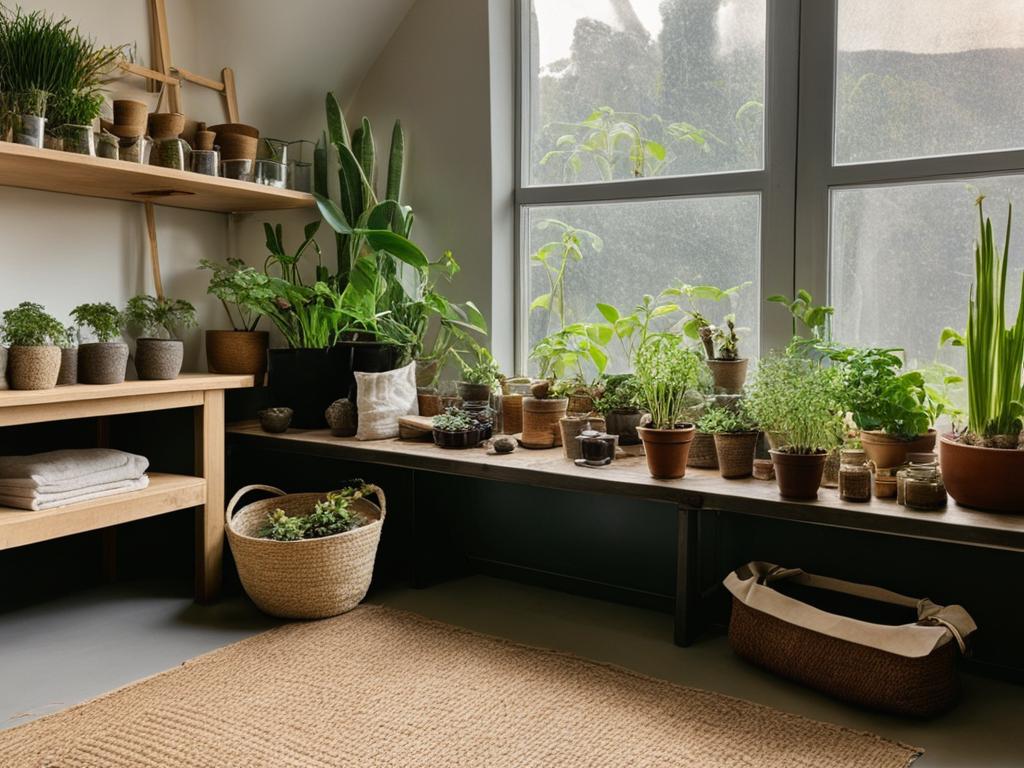
Comparison of DIY vs. Professional Mushroom Removal
| Criteria | DIY Mushroom Removal | Professional Mushroom Removal |
|---|---|---|
| Efficiency | May not effectively eliminate all spores and traces of mushrooms. | Thorough removal, ensuring minimal chances of regrowth. |
| Safety | Risk of spreading spores and exacerbating the problem. | Adheres to industry standards for safe removal and disposal. |
| Expertise | Relies on limited knowledge and DIY methods. | Experienced professionals with expertise in mold remediation. |
| Long-term Results | May not address the underlying moisture issue, leading to future growth. | Identifies the root cause and provides solutions to prevent recurrence. |
Causes of Mushroom Growth Indoors
Poor ventilation, water intrusion, and leaking pipes are common causes of mushroom growth indoors. These conditions lead to a build-up of moisture, creating a conducive environment for mold and mushrooms to thrive. To prevent mushroom growth, it is crucial to address these underlying issues and ensure proper ventilation and moisture control in your home.
Proper ventilation plays a vital role in preventing excess moisture accumulation, which is a primary requirement for mushroom growth. Ensure that your home has sufficient airflow by opening windows, using exhaust fans, or installing a ventilation system.
Water intrusion and leaking pipes provide a direct source of moisture that promotes mushroom growth. Regularly inspect your home and fix any water leaks promptly. Addressing any plumbing issues, such as dripping faucets or leaking pipes, will help in preventing the accumulation of moisture and subsequently inhibit mushroom growth.
In addition to proper ventilation and addressing water intrusion, controlling indoor humidity levels is essential for preventing mushroom growth. Use a dehumidifier to remove excess moisture from the air, particularly in areas prone to dampness, such as basements or bathrooms. Maintaining an ideal humidity level between 30% and 50% can significantly reduce the risk of mold and mushroom growth.
Implementing these mushroom growing tips and techniques will help maintain a healthy and mold-free environment in your home, ensuring the well-being of you and your family.
Key Takeaways:
- Poor ventilation, water intrusion, and leaking pipes contribute to mushroom growth indoors.
- Ensure proper ventilation in your home through windows, exhaust fans, or ventilation systems.
- Regularly inspect your home for water leaks and address plumbing issues promptly.
- Control indoor humidity levels with a dehumidifier to prevent excess moisture.
- Implementing these mushroom growing tips and techniques will help maintain a mold-free environment.
Conditions that Promote Mushroom Growth Indoors
Mushroom growth indoors can be influenced by specific conditions that create a favorable environment for their cultivation. Understanding these factors is crucial for preventing and controlling mushroom growth in your home.
- Moisture: Mushrooms thrive in moist environments, making excess humidity a primary factor for their growth. When the indoor humidity level is high, it creates the perfect breeding ground for mold and mushrooms. Proper moisture control is essential to prevent mushroom growth.
- Decomposing Materials: Decomposing organic materials, such as rotting wood, damp carpets, or wet insulation, provide the ideal food source for mushrooms. If any such materials are present in your home, they can contribute to mushroom growth. It is important to address and remove these materials promptly.
- High Humidity Levels: Elevated humidity levels, especially above 60%, create an environment conducive to mushroom growth. This moisture-rich atmosphere promotes spore germination and mycelium development. Monitoring and controlling indoor humidity levels is vital in preventing mushroom growth.
Proper ventilation, moisture control, and fixing water leaks are essential strategies to prevent mushroom growth indoors.
Avoiding Mushroom Growth through Ventilation and Moisture Control
Two effective ways to prevent mushroom growth indoors are ensuring proper ventilation and controlling moisture levels.
Ventilation: Good airflow and ventilation help to regulate indoor humidity levels and prevent moisture build-up. Opening windows, using exhaust fans, and installing air purifiers can aid in maintaining a dry and well-ventilated living space.
Moisture Control: To prevent excessive moisture and condensation, follow these tips:
- Avoid drying clothes indoors.
- Fix any water leaks or plumbing issues promptly.
- Use dehumidifiers in areas prone to high humidity.
- Ensure proper insulation to prevent condensation on walls and ceilings.
- Clean and dry any spills or water damage immediately.
By implementing proper ventilation and moisture control measures, you can create an environment that discourages mushroom growth and maintains a dry and healthy home.
Comparative Guide for Preventing Mushroom Growth Indoors
| Prevention Strategies | Effectiveness | Difficulty Level | Cost |
|---|---|---|---|
| Proper ventilation | Highly effective | Easy | Low |
| Moisture control | Highly effective | Moderate | Varies (depends on specific measures) |
| Regular inspection | Effective | Easy | Low |
| Removing decomposing materials | Effective | Moderate | Varies (depends on extent of removal) |
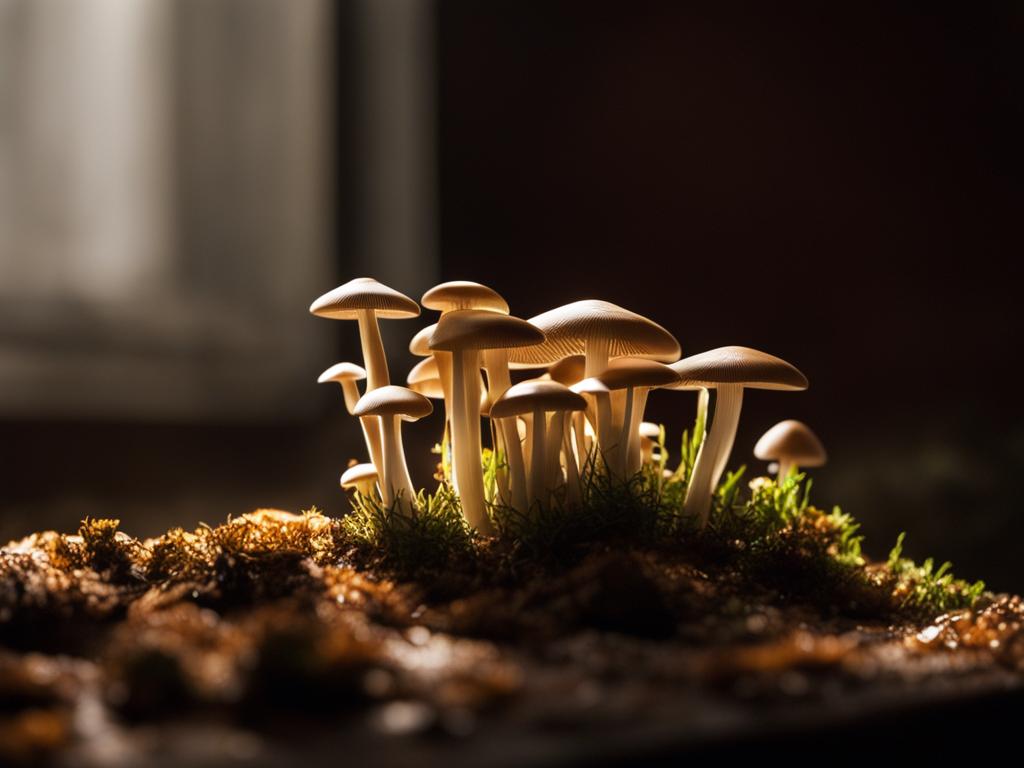
Following these preventive measures significantly reduces the chances of mushroom growth in your home. By maintaining proper ventilation, controlling moisture, and promptly addressing any underlying issues, you can create an environment that discourages the growth of mushrooms and promotes a healthy living space.
Case Study: Mushroom Growth due to Water Leak
A case study in Kensington, London, revealed an interesting connection between mushroom growth, water leaks, and carpet mold. In this particular instance, the presence of mushrooms was caused by a hidden bathroom leak and a prolonged period of leaving the heating on in a vacant property, creating a humid environment conducive to mushroom growth.
The water leak resulted in damage to the ceiling and walls, leading to moisture seeping into the carpet. This moisture, combined with the high humidity, provided the ideal conditions for mushrooms to flourish. As a result, mushrooms started sprouting in the affected carpet areas.
The issue was promptly addressed through a thorough inspection of the property. The hidden bathroom leak was identified and repaired, ensuring that no further water intrusion would occur. The damaged ceiling and walls were also repaired to prevent any residual moisture from contributing to future mold growth. Lastly, the affected carpet was carefully removed and replaced to eliminate the mushrooms and carpet mold.
By swiftly attending to the water leak and taking appropriate remedial actions, the homeowner successfully eradicated the mushroom growth and prevented any potential health hazards associated with carpet mold.
Case Study Summary:
| Location | Cause | Consequence | Action Taken |
|---|---|---|---|
| Kensington, London | Hidden bathroom leak, prolonged heating | Mushroom growth in carpet | Repair leak, fix damaged areas, replace carpet |
Health Risks of Mushroom Growth in Home
Mushroom growth in the home can pose significant health risks. The presence of mushrooms indicates the presence of mold, which releases spores that can trigger allergies, respiratory issues, and asthma symptoms in sensitive individuals. Mold exposure can have various adverse effects on human health.
Allergy and Respiratory Issues
Mold spores, which are present in mushrooms, can cause allergic reactions in susceptible individuals. Common symptoms include sneezing, coughing, itchy eyes, and skin rashes. People with respiratory conditions such as asthma may experience worsened symptoms when exposed to mold spores.
Mycotoxins and Toxicity
Some molds produce mycotoxins, which are toxic substances. Ingesting or inhaling these mycotoxins can lead to adverse health effects. Symptoms may range from mild discomfort to more severe reactions, depending on the individuals and the specific mold species present.
Immune System Weakness
Prolonged exposure to mold can weaken the immune system, making individuals more susceptible to infections and illnesses. Mold spores and mycotoxins can compromise the body’s natural defense mechanisms, leaving individuals more vulnerable to respiratory infections and other health issues.
It is important to address mushroom growth in your home promptly to protect your health and the well-being of your family. Proper measures should be taken to eliminate mold and prevent its recurrence.
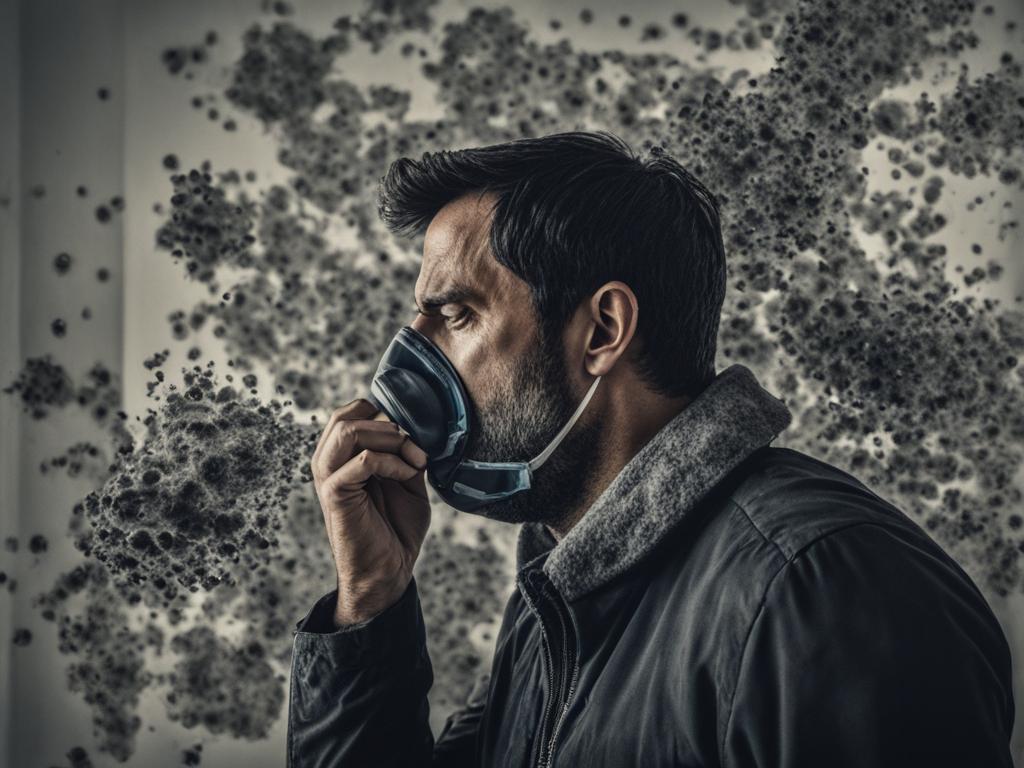
Identifying Types of Mushroom Mold Growth
When it comes to molds that can grow on mushrooms, there are several species to be aware of. These molds can vary in color and appearance, ranging from black to green, white, or gray. Understanding the different types of mold that can be found on mushrooms is crucial in determining the appropriate remediation and prevention measures.
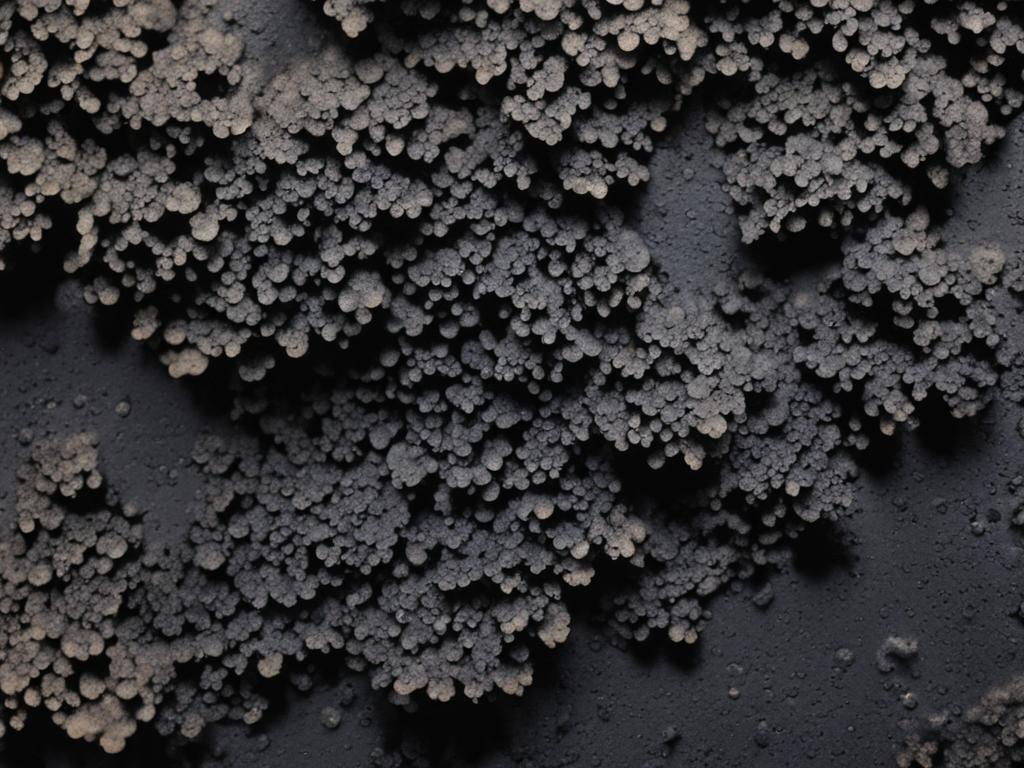
Common Mold Species Found on Mushrooms:
| Mold Species | Color | Potential Effects |
|---|---|---|
| Aspergillus | Green, Yellow, or Black | Produces mycotoxins that can cause respiratory issues and allergic reactions. |
| Penicillium | Green, Blue, or White | May cause allergic reactions and produce mycotoxins harmful to human health. |
| Cladosporium | Black or Green | Can provoke allergies and trigger respiratory symptoms in sensitive individuals. |
While these are just a few examples, it is important to note that there are many other mold species that can be found on mushrooms. Proper identification of the mold species is essential in determining the appropriate steps for remediation and prevention.
“Different mold species can have different impacts on human health. Some produce mycotoxins, which are toxic substances that can cause a variety of health problems, while others can trigger allergies and respiratory issues. Understanding the specific mold species present is key to effectively addressing the problem.”
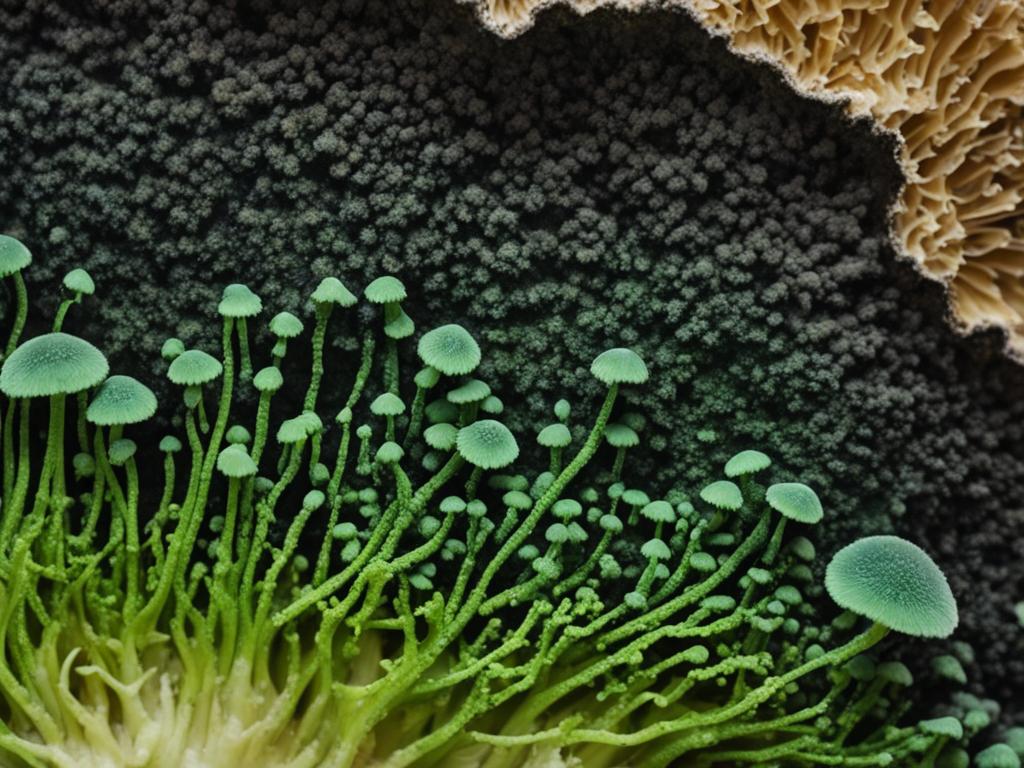
Preventing Mushroom Growth in Your Home
Regular inspections and proactive measures are crucial in preventing mushroom growth in your home. By addressing potential moisture sources and controlling indoor moisture levels, you can effectively keep mold and mushrooms at bay. Here are some key strategies to implement:
1. Regular Inspections
Perform regular inspections of your home to identify any signs of water intrusion, leaks, or excess moisture. Check for dampness, condensation, or musty odors, especially in areas prone to moisture accumulation such as basements, bathrooms, and kitchens.
2. Address Potential Moisture Sources
Identify and address potential moisture sources in your home that can lead to mushroom growth. This includes fixing leaking pipes, repairing roof leaks, and sealing any cracks or gaps that may allow water infiltration. By eliminating these sources, you can prevent moisture buildup and create an inhospitable environment for mushrooms to thrive.
3. Maintain Proper Ventilation
Proper ventilation is essential in controlling indoor moisture levels and preventing mushroom growth. Ensure that your home is adequately ventilated by using exhaust fans in bathrooms and kitchens, opening windows to allow fresh air circulation, and using air purifiers with HEPA filters to remove airborne mold spores.
4. Use Dehumidifiers
Controlling indoor humidity levels is crucial in preventing excess moisture and mold growth. Consider using dehumidifiers in areas of your home that are prone to high humidity, such as basements or laundry rooms. This will help maintain optimal humidity levels and inhibit mushroom growth.
5. Regular Cleaning and Removal of Organic Materials
Regularly clean your home, paying special attention to areas where organic materials may accumulate moisture, such as carpets, curtains, or damp basements. Remove any decaying materials promptly and ensure proper drying to prevent the growth of mushrooms.
By implementing these preventive measures, you can maintain a mold-free and healthy living environment in your home.
| Preventive Strategies | Benefits |
|---|---|
| Regular inspections | Early detection of potential moisture issues |
| Addressing potential moisture sources | Preventing water intrusion and leaks |
| Maintaining proper ventilation | Controlling indoor moisture levels |
| Using dehumidifiers | Reducing excess humidity and mold growth |
| Regular cleaning and removal of organic materials | Preventing moisture accumulation and mushroom growth |
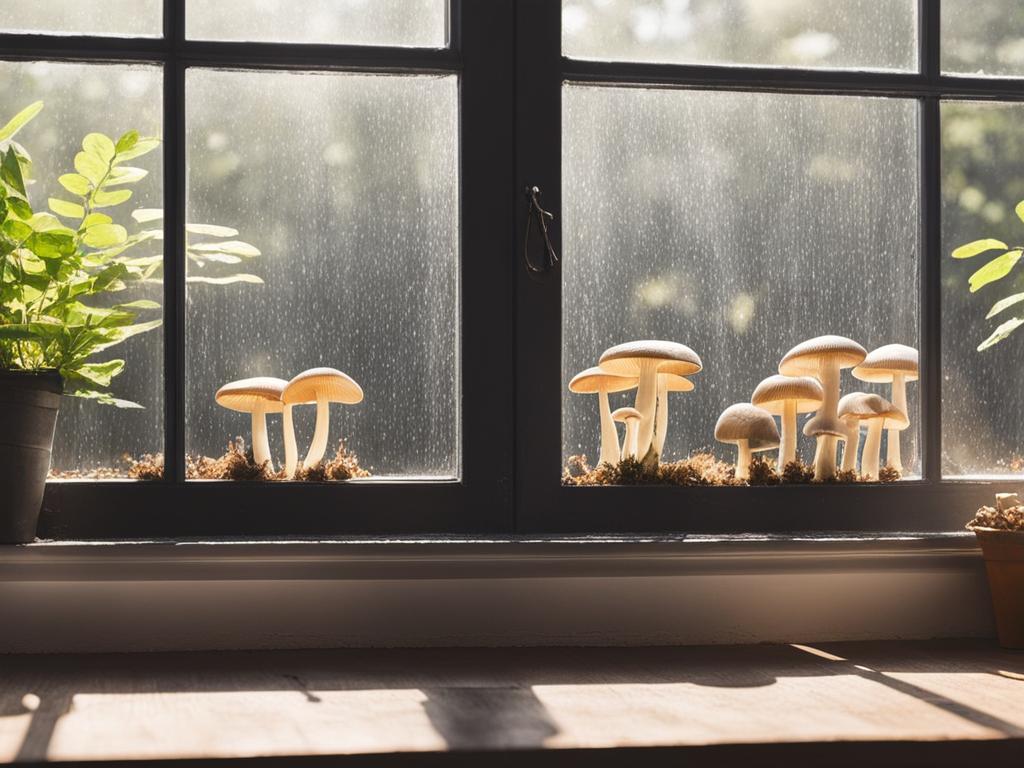
“Regular inspections and proactive measures are essential in preventing mushroom growth in your home. By addressing potential moisture sources and controlling indoor moisture levels, you can effectively keep mold and mushrooms at bay.”
Safely Removing Mushroom Mold from Your Home
When dealing with small mold infestations, you have the option of DIY mold removal techniques using mild detergents or vinegar solutions, which can be effective. However, it’s important to note that for extensive mold growth or if you’re dealing with toxic mold species, it is highly recommended to seek professional mold remediation services. These professionals have the expertise and specialized equipment to safely and effectively remove mold from your home, ensuring the complete elimination of mold spores and preventing future growth.
Professional mold remediation services follow stringent protocols to ensure the safe removal of mold. They employ advanced techniques, such as containment measures, to prevent the spread of mold spores during the removal process. This helps protect the health of both the occupants and the workers involved in the remediation process.
After the mold removal process is complete, it is crucial to take preventive measures to control moisture and maintain air quality in your home. This helps to prevent the recurrence of mold growth. Here are some important steps to follow:
- Identify and address any sources of moisture or leaks in your home. This may involve fixing plumbing issues, improving ventilation, or installing dehumidifiers in damp areas.
- Regularly clean and dry surfaces prone to moisture, such as bathrooms, kitchens, and basements.
- Keep humidity levels in check by using air conditioners, exhaust fans, or opening windows to promote proper air circulation.
- Consider using moisture-absorbing materials, such as silica gel packets or moisture absorbers, in areas prone to dampness.
- Monitor indoor humidity levels using a hygrometer and aim to keep it below 50% to discourage mold growth.
- Ensure proper ventilation in your home, especially in areas where moisture tends to accumulate.
- Regularly inspect your home for any signs of mold growth, such as musty odors, discoloration on walls, or water stains.
Taking these preventive measures will help create an environment that is inhospitable to mold growth. Additionally, maintaining a clean and healthy living space can further reduce the risk of respiratory issues or allergies associated with mold exposure.
Expert Quote:
“Proper mold removal requires specialized knowledge and equipment. For large-scale or toxic mold infestations, it is always best to rely on professional mold remediation services to ensure thorough and safe removal.”
– Dr. Emily Johnson, Certified Mold Specialist
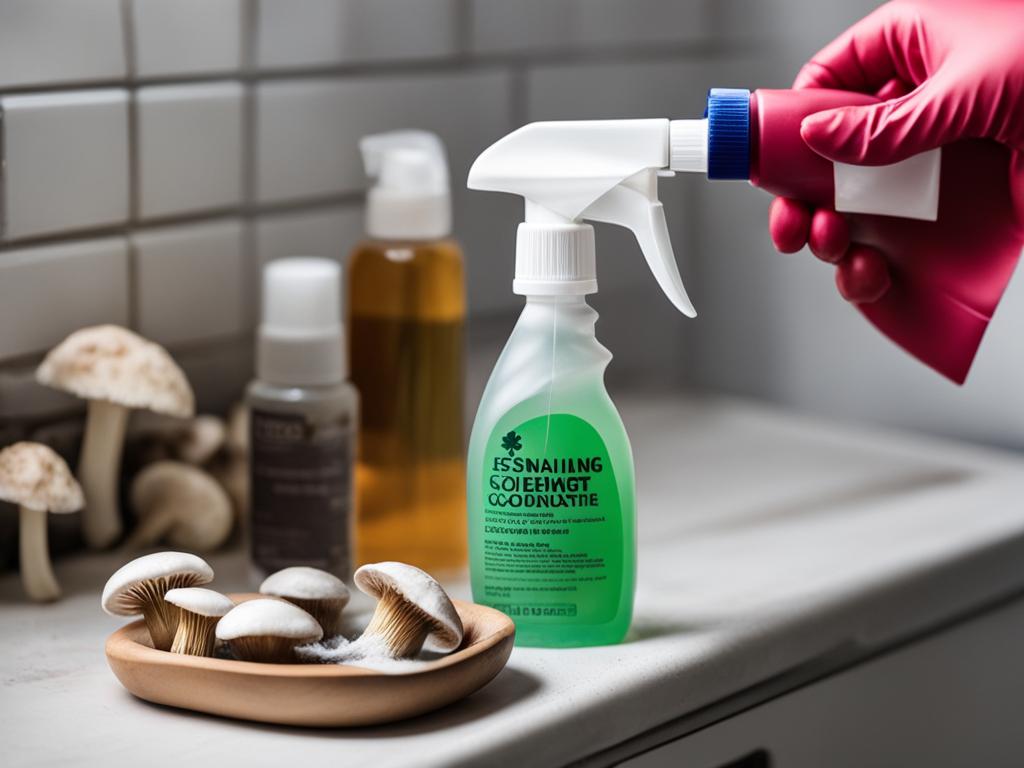
| Diy Mold Removal | Professional Mold Remediation Services |
|---|---|
| Can be effective for small mold infestations | Recommended for extensive mold growth or toxic mold species |
| Requires proper use of protective gear and equipment | Utilizes specialized equipment and techniques for safe mold removal |
| May not effectively eliminate all mold spores | Thoroughly eliminates mold spores to prevent future growth |
| Does not address the underlying cause of mold growth | Identifies and addresses the root cause of mold growth |
| May pose health risks if not done properly | Follows strict safety protocols to protect your health during the remediation process |
Post-Removal Precautions and Prevention
After successfully removing mushroom mold from your home, it is crucial to implement post-removal precautions and preventive measures to ensure a mold-free and healthy living environment. By taking these necessary steps, you can effectively control moisture levels, maintain proper ventilation, and reduce the presence of mold spores in the indoor air.
Controlling Moisture Levels
The first step in preventing the recurrence of mushroom mold is to address any moisture issues in your home. Moisture provides the ideal breeding ground for mold growth, so it is crucial to keep your indoor spaces dry. Here are some tips to control moisture levels:
- Fix any plumbing leaks or water intrusion points promptly.
- Ensure proper drainage around your home’s foundation to prevent water seepage.
- Use dehumidifiers in areas prone to excess moisture, such as basements or bathrooms.
- Regularly empty and clean your dehumidifier to maintain its effectiveness.
- Avoid overwatering indoor plants or allowing water to accumulate in trays.
Maintaining Proper Ventilation
Proper ventilation is essential in preventing the buildup of stagnant air and excess moisture. It helps in circulating fresh air, reducing humidity levels, and preventing the growth of mold and mushrooms. Consider the following ventilation practices:
- Open windows and use fans to improve air circulation.
- Install exhaust fans in bathrooms, kitchens, and other areas prone to moisture.
- Ensure that your dryer vents are properly vented to the exterior of your home.
- Regularly clean and maintain ventilation systems, including air ducts and filters.
Regular Inspections for Signs of Mold Growth
Vigilance is key to preventing the reemergence of mushroom mold in your home. Regular inspections can help you catch any signs of mold growth early on and take appropriate action. Pay close attention to the following areas:
- Check for any signs of water damage, such as discoloration or bulging walls.
- Inspect areas prone to moisture, such as basements, bathrooms, and crawl spaces.
- Keep an eye on areas where mushrooms may have previously grown.
By being proactive and conducting regular inspections, you can quickly address any mold issues before they escalate.
| Preventive Measure | Description |
|---|---|
| Using Air Purifiers |
Install air purifiers with HEPA filters in your home to improve indoor air quality and reduce the presence of mold spores. HEPA filters effectively capture tiny particles, including mold spores, ensuring cleaner and healthier air. |
| Regular Cleaning |
Maintain a clean and clutter-free home by regularly cleaning and dusting surfaces. Remove any organic materials that may accumulate moisture, such as cardboard boxes, old newspapers, or damp fabrics. |
| Monitor Humidity Levels |
Use a hygrometer to monitor and maintain optimal indoor humidity levels between 30% and 50%. This helps prevent excess moisture that can contribute to mold growth. |
Implementing these preventive measures can significantly reduce the risk of mushroom mold reemergence and ensure a healthy living environment for you and your family.
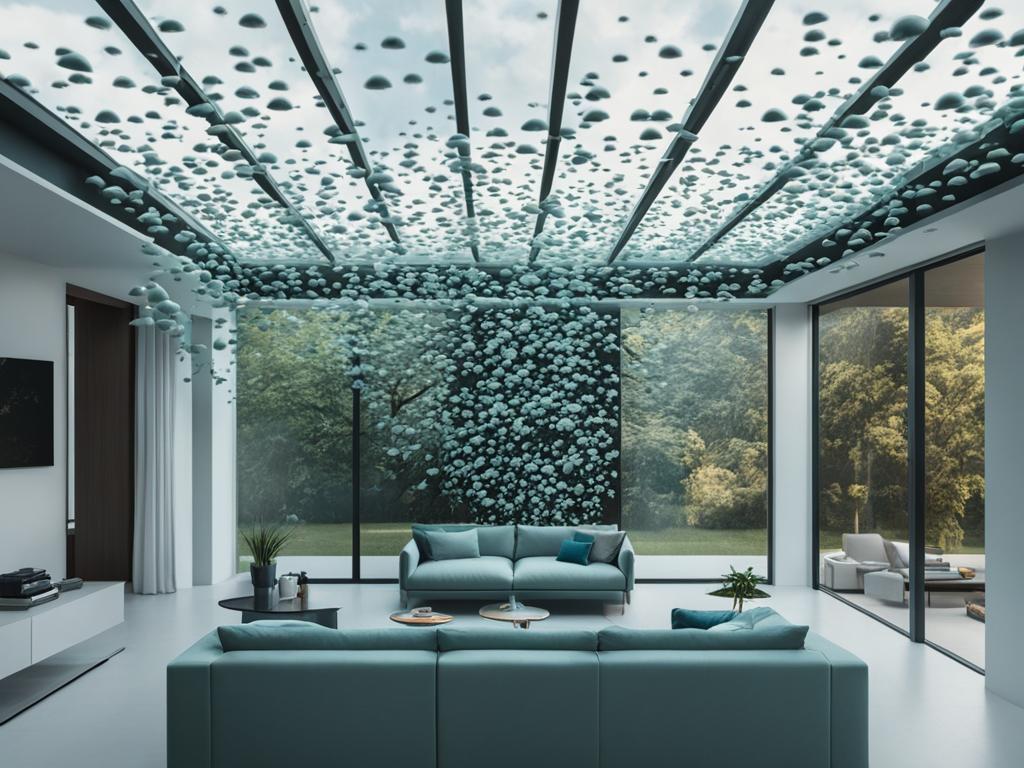
Conclusion
Addressing and eliminating mushroom growth in your home is crucial for maintaining a mold-free and healthy living environment. The presence of mushrooms indicates underlying moisture and mold issues, which can have negative effects on your health. By conducting regular inspections, controlling moisture levels, and ensuring proper ventilation, you can prevent and eliminate mushroom growth.
It is important to take proactive measures to address the root causes of moisture, such as water intrusion or leaks, and fix them promptly. Professional assistance, such as a chartered building surveyor, can help identify the source of the moisture issue and provide appropriate solutions. Additionally, cleaning affected areas with the help of a professional cleaning service is essential to remove any traces of mold.
Creating a mold-free home also involves taking preventive measures, such as using dehumidifiers, exhaust fans, and air purifiers with HEPA filters to control moisture and improve indoor air quality. Regularly inspecting your home for any signs of mold growth and promptly addressing any issues that arise will help keep your living environment healthy and mold-free.
FAQ
What causes mushrooms to grow indoors?
Mushrooms growing indoors are a result of excessive moisture and humidity. They thrive in damp environments and are often a sign of water damage or leaks. The presence of mushrooms indicates the presence of mold, which can be harmful to your health. It is important to address the underlying moisture issue to prevent further mushroom growth.
How can I remove mushrooms from my home?
Simply removing mushrooms from your home will not solve the problem. Professional help, such as a chartered building surveyor, is recommended to identify the root cause of the moisture issue and suggest appropriate steps to fix it. A professional cleaning service should be used to clean the area affected by mushroom growth. If you’re renting, contact your landlord or management agent to report the issue and follow the terms of your lease for repairs.
What are the causes of mushroom growth indoors?
Poor ventilation, water intrusion, and leaking pipes are common causes of mushroom growth indoors. These conditions lead to a build-up of moisture, creating a conducive environment for mold and mushrooms to thrive. To prevent mushroom growth, it is crucial to address these underlying issues and ensure proper ventilation and moisture control in your home.
What conditions promote mushroom growth indoors?
Mushroom growth indoors is promoted by factors such as decomposing materials, moist environments, and high humidity levels. It is important to keep your home dry and well-ventilated to prevent moisture buildup and mold growth. Proper ventilation, using dehumidifiers, and fixing water leaks are effective strategies to control moisture and prevent mushroom growth.
Are there any case studies on mushroom growth due to water leaks?
A case study in Kensington, London, revealed that mushroom growth was caused by a hidden bathroom leak and a humid environment created by leaving the heating on in a vacant property for an extended period. The water leak led to damage in the ceiling and walls, along with the growth of mushrooms in the carpet. The affected areas were inspected, repaired, and the carpet was replaced to address the issue.
What are the health risks of mushroom growth in the home?
Mushroom growth in the home can pose health risks. Mold spores, which are present in mushrooms, can trigger allergies, respiratory issues, and asthma symptoms in sensitive individuals. Some molds produce mycotoxins that can be harmful if inhaled or ingested. Prolonged exposure to mold can weaken the immune system and lead to infections. It is important to address mushroom growth to protect your health.
What types of mold can grow on mushrooms?
Several mold species can grow on mushrooms, including Aspergillus, Penicillium, and Cladosporium. These molds vary in color and appearance, ranging from black to green, white, or gray. Some mold species can produce mycotoxins, while others can cause allergic reactions or respiratory issues. Proper identification of mold species can help in determining the appropriate remediation and prevention measures.
How can I prevent mushroom growth in my home?
Regular inspections of your home, addressing potential moisture sources, and maintaining proper ventilation are essential for preventing mushroom growth. Controlling indoor moisture levels through the use of dehumidifiers, exhaust fans, and air purifiers can help in keeping mold and mushrooms at bay. Regular cleaning and removal of organic materials that may accumulate moisture are also important in preventing mushroom growth.
How can I safely remove mushroom mold from my home?
For small mold infestations, DIY mold removal techniques using mild detergents or vinegar solutions can be effective. However, for extensive mold growth or toxic mold species, it is recommended to seek professional mold remediation services. They have the expertise and equipment to safely and effectively remove mold from your home. After mold removal, taking preventive measures to control moisture and maintain air quality is crucial.
What precautions should I take after removing mushroom mold from my home?
After removing mushroom mold from your home, it is important to take precautions to prevent its recurrence. This includes controlling moisture levels, maintaining proper ventilation, and regular inspections for signs of mold growth. Using air purifiers with HEPA filters can help in improving indoor air quality and reducing the presence of mold spores. Taking preventive measures can ensure a mold-free and healthy living environment.

